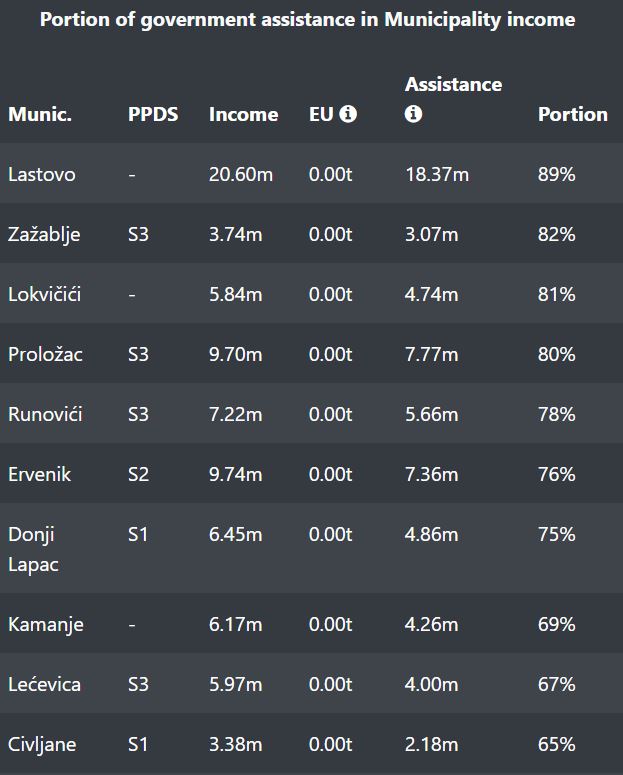June 21, 2020 - Croatia's bloated bureaucracy is not sustainable. Glas Poduzetnika data scientist Nikola Strahija uses big data to show how merging municipalities can save 1.29 BILLION kuna (170 million euro) a year.
When I first moved to Hvar back in 2002, I was surprised to learn that my new hometown of Jelsa had its own mayor and tourist board director. There were only 1,750 people in the entire municipality to administer. I was even more surprised to then learn that this beautiful island of 11,000 permanent residents had no less than FOUR mayors and FIVE tourist board directors, each with its own administrative support team.
That is a LOT of public sector workers.
Who were not that efficient, or interested in being efficient. I will never forget one tourist many years ago at the Jelsa Tourist Board office asking what there was to do in Stari Grad, as he was considering a bus trip the next day.
"The bus leaves at these times (points to bus schedule) and the Stari Grad Tourist Board is close to the bus station. They can tell you everything about Stari Grad."
Back then, I was naive and knew nothing of Uhljebistan, the nepotism and jobs for the cousins, their families and other voters, to perpetuate the corrupt status quo. If we merged all these administrations into one, how much more efficient would we be, and how much money could we then invest in building a better country?
About 1.29 billion kuna a year (170 million euro) seems to be the answer.
Some 18 years after my arrival, the Mighty State of Uhljebistan is facing a twin virus attack from the Terrible Twins - Transparency and Technology. Corona has laid bare many of the system's failings, and now the Terrible Twins will expose the truth in minute detail.
It was a real pleasure to have only my third Zoom chat ever yesterday, this time with Glas Poduzetnika data scientist, Nikola Strahija, who has compiled some quite phenomenal research using machine learning and other clever stuff I don't really understand.
Meet the municipality which spends 72% of its budget on salaries, with 82% of its budget coming from government assistance (no, I had never of the place either), just one of the many gems Nikola's research unearthed. In the words of Glas Poduzetnika (UGP - Voice of Entrepreneurs):
The analysis of UGP data scientist Nikola Strahija revealed facts that the Croatian Government has not been able to present to citizens for years.
By abolishing unsustainable local self-government units, Croatia can save at least one billion kuna a year.
A member of the UGP, data scientist Nikola Strahija, came up with astonishing data using machine learning - abolishing the financially unsustainable 430 units of local self-government would save at least one billion kuna a year.

Over the last ten years, the cumbersomeness of public administration and the addition of many local self-government units has been a frequent topic. It was again actualized in the coronavirus crisis, when on daily examples, all the absurdity of the division of local self-government units came to the fore. It has become apparent that some of them do not even have the basic things that residents need on a daily basis, and yet they have their own municipality and mayor. Also, there is even an example of a settlement located in two municipalities. Croatia has over 100 units that cannot function without state aid. By merging them, great savings can be made, and these funds can be redirected to many places and projects.

Due to all the above, a member of the association Voice of Entrepreneurs Nikola Strahija decided to make a map of the optimal territorial organization of local self-government units. He did this using machine learning, and used the geolocation and financial reports for 2018 as the basis of logic.
The result is approximately 430 fewer local units and about a billion kuna in savings per year.
Clicking on the new, proposed self-government unit displays all merged units and financial indicators, such as cost per capita before and after, expenditure before and after, total salaries, total benefits paid to citizens, etc.
The map goes into incredible detail with financials and showing which municipalities are not sustainable and should be merged. Have a wander around the map here.
A phenomenal piece of work, young man, and I look forward to working with you on the project we discussed yesterday.
For the latest from Glas Poduzetnika, check out the dedicated TCN section.



